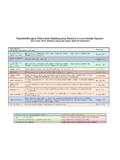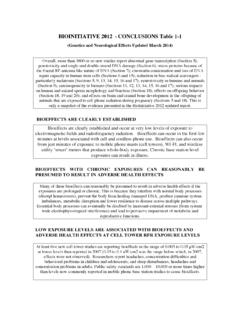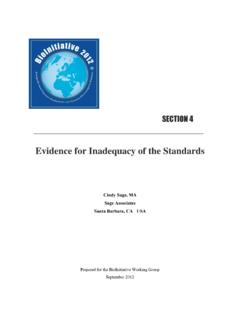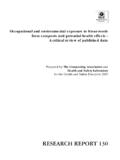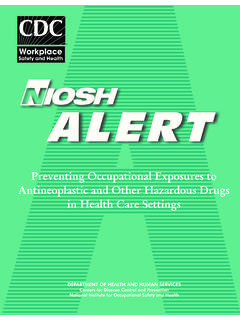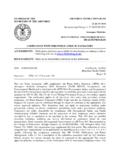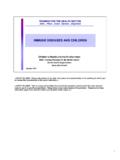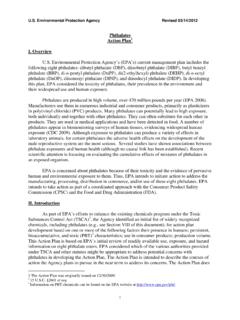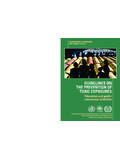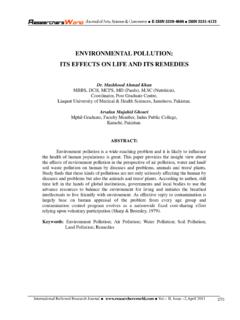Transcription of Precaution in Action Global Public Health Advice …
1 SECTION 22. Precaution in Action Global Public Health Advice Following BioInitiative 2007. Dr. Gerd Oberfeld, MD. Public Health Department Regional Government Office of the Land Salzburg Salzburg, Austria Speaker Environmental Medicine Austrian Medical Association Vienna, Austria Prepared for the BioInitiative Working Group October 2012. TABLE OF CONTENTS. I. Introduction II. Publications and Health Agency Advisories (2007 2012). The BioInitiative Report (2007). European Environment Agency (2007). European Parliament (2007). European Parliament (2008). Pathophysiology Journal Publication - Special Issue on EMF (2009). The European Environment Agency Director's Statement (2009). European Parliament (2009). Seletun Statement (2009). Collegium Ramazzini Publication (2010). European Environment Agency (2011).
2 Council of Europe (2011). European Environment Agency (2011). US General Accounting Office (2012). European Environment Agency- Late Lessons II - Mobile Phone Chapter (2012). III. Expert Research Group and Physicians' Advisories (2007 2012). American Academy of Environmental Medicine (2012). International Doctors Appeal (2012). American Academy of Pediatrics (2012). IV. Local and National Country Actions (2007 2012). City of Brussels Principality of Liechtenstein (2008). Italy Autonomous Province of Bolzano - South Tyrol (2009). Austria Ministry of Health (2010). France (2010). Austria Austrian Medical Association (2012). Russian National Committee on Non-Ionizing Radiation (2011 and 2012). V. International Health Agency Action WHO International Agency for Research On Cancer Formal Classification (2011).
3 VI. References VIII. Appendices A: European Parliament Recommendation (2008). B: European Parliament Resolution (2009). C: American Academy of Environmental Medicine (2012). D. American Academy of Pediatrics (2012). E. Russian National Committee on Non-Ionizing Radiation (Mobile Phones and Children - 2011). F. Russian National Committee on Non-Ionizing Radiation (To Regulate WI-FI in Schools -2012). 2. I. INTRODUCTION. This section highlights some major milestones in documentation of potential Health effects of low- intensity electromagnetic fields and radiofrequency radiation, and subsequent national and international actions taken to address the problem. The categories of response are divided into Publications and Health Agency Advisories, Local and National Country Actions, Expert Research Group and Physicians' Advisories and the formal classification by the World Health Organization International Agency for Research on Cancer for RFR as a 2B Possible Human Carcinogen.
4 II. PUBLICATIONS AND Health AGENCY ADVISORIES (2007 2012). The BioInitiative Report (2007). The BioInitiative Report (1) is a 650+ page report documenting the evidence for bioeffects and adverse Health effects (the science and Public Health consequences of that body of scientific evidence) from electromagnetic field and radiofrequency (microwave) radiation. It was written by an independent international research group to give an overview of what is known of biological effects that occur at low-intensity EMFs exposures (for both radiofrequency radiation RFR and power-frequency ELF-EMF), and various forms of combined exposures that are now known to be bioactive). The Report examines the research and current standards and finds that these standards are far from adequate to protect Public Health . The report presents solid science on this issue, and makes recommendations to decision-makers and the Public .
5 The BioInitiative Working Group was composed of scientists, researchers and Public Health policy professionals. In 2007, the Working Group documented information from over 2000 published scientific studies and reviews reporting bioeffects and adverse Health impacts of electromagnetic fields and radiofrequency radiation at exposure levels far below current Public safety standards that should be considered in the international debate about the adequacy (or inadequacy) of existing Public exposure standards. Eleven chapters documented key scientific studies and reviews identifying low-intensity effects of electromagnetic fields. Sections 16 and 17 were prepared by Public Health and policy experts. These sections discuss the standard of evidence which should be applied in Public Health and environmental planning, how the scientific information should be evaluated in the context of prudent Public Health policy, and the basis for taking precautionary and preventative actions that are proportionate given this evidence.
6 3. European Environment Agency (2007). European Environmental Agency Executive Director Jacqueline McGlade, PhD provided early support for the BioInitiative Report (2007). The Agency's Head of Communications and Corporate Affairs issued a news release on the publication of the BioInitiative Report, and the EEA. contributions to it on September 17, 2007, two weeks after the Report was published on the web. It stated (2): A new report raising concerns about the effects of electromagnetic fields (EMF) on human Health calls for tougher safety standards to regulate radiation from mobile phones, power lines and many other sources of exposure in daily life. The report, 'Bioinitiative: A Rationale for a Biologically- Based Public Exposure Standard for Electromagnetic Fields' was compiled by the BioInitiative Working Group, an international group of scientists, researchers and Public Health policy professionals.
7 The EEA has contributed to this new report with a chapter drawn from the EEA study 'Late lessons from early warnings: the precautionary principle 1896 2000' published in 2001.. The EEA study reviews the histories of a selection of Public and environmental hazards, such as asbestos, benzene and PCBs, from the first scientifically based early warnings about potential harm, to subsequent precautionary and preventive measures. Cases on tobacco smoking and lead in petrol are forthcoming.. Although the EEA does not have specific expertise in EMF, the case studies of Public hazards analyzed in the 'Late Lessons from Early Warnings' publication show that harmful exposures can be widespread before there is both 'convincing' evidence of harm from long-term exposures, and biological understanding of how that harm is caused.
8 There are many examples of the failure to use the precautionary principle in the past, which have resulted in serious and often irreversible damage to Health and environments. Appropriate, precautionary and proportionate actions taken now to avoid plausible and potentially serious threats to Health from EMF are likely to be seen as prudent and wise from future perspectives. We must remember that Precaution is one of the principles of EU environmental policy.. Professor Jacqueline McGlade, Executive Director, EEA. In the fall of 2007, the EEA Director responsed to strong media and industry attention to the BioInitiative Report, defending the EEA's position to declare early warnings' appropriate with respect to the evidence on mobile phone radiofrequency radiation and possible Health hazards. The Director defended EEA recommendations for prudent Public Health Action , based on the scientific evidence presented in the BioInitiative Report.
9 (3). The BioInitiative report draws attention to some of the emerging evidence of potential harm from the long term effects of non-ionising radiations from electro and magnetic fields (EMF), particularly from the radio frequency (RF) exposures that arise from mobile phone telecommunications.. The Bioinitiative report, however, is only one of several reports reviewing the risks from the 4. thermal and non-thermal effects of EMF that have been published over recent years.. These include reports from the NIEHS, the EU, the WHO, the UK National Radiological Protection Board and others The EEA's contribution to the BioInitiative report was a chapter on the history and general application of the precautionary principle to a number of well known hazards for which there had been, and in some cases still is, much scientific uncertainty.
10 The chapter summarised the main messages from our report, Late Lessons from Early Warnings: the Precautionary Principle 1896-2000 , (EEA 2001).. The point of our chapter for the BioInitiative report was to illustrate how past uncertainties had been dealt with so as to provide lessons that may be helpful in dealing with current hazards for which there is both scientific uncertainty and high stakes, both Health and economic.. It is because this accumulating evidence on RF is of increasing scientific concern, and because the exposure of the Public , particularly vulnerable groups, is widespread and generally rising, that we judged it was timely to draw wider attention to the possibly serious hazards from EMF . In our judgement, the human and experimental evidence, taken together, is clear enough to support using the precautionary principle to justify reducing exposures, where feasible, and to review the evidence for the existing exposure limits, which, as you know, are based on thermal effects only.
